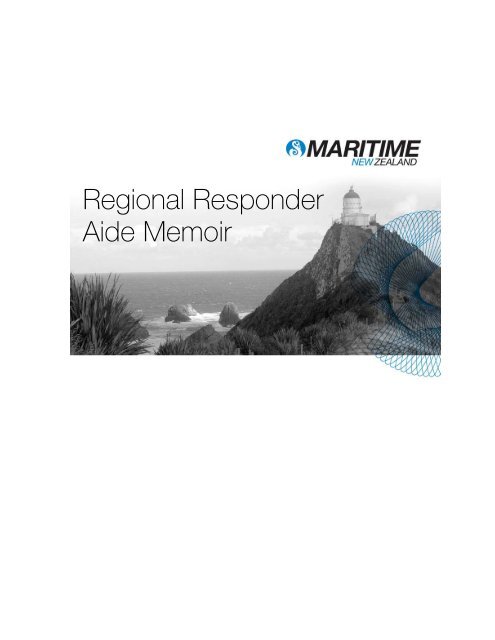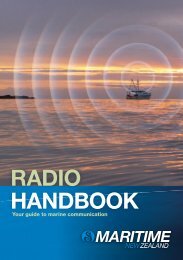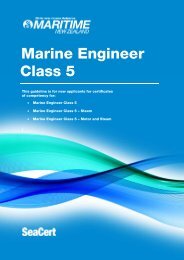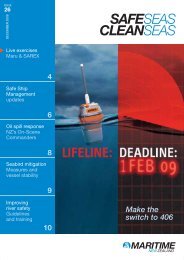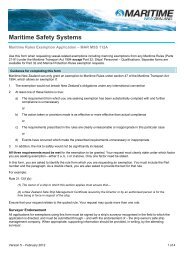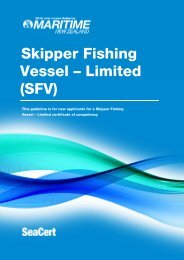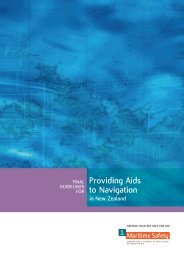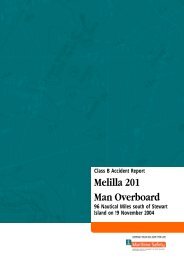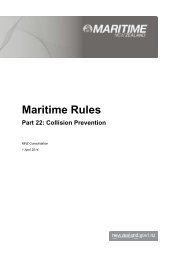Regional Responders Aide Memoir - Maritime New Zealand
Regional Responders Aide Memoir - Maritime New Zealand
Regional Responders Aide Memoir - Maritime New Zealand
You also want an ePaper? Increase the reach of your titles
YUMPU automatically turns print PDFs into web optimized ePapers that Google loves.
<strong>Regional</strong> Responder<br />
<strong>Aide</strong> <strong>Memoir</strong><br />
1
<strong>Regional</strong> Responder <strong>Aide</strong> <strong>Memoir</strong><br />
1. Phases Of An Oil Spill Flowchart<br />
2. Tier Determination Flowchart<br />
3. Spill Response Activities<br />
4. To Respond To A Spill<br />
5. Calculating Volume Of Oil<br />
6. Volume Calculation Example And Movement Trajectory<br />
7. All About Oil<br />
8. Situation Evaluation And Range Of Response Options<br />
9. Pollution Incident Evaluation Form<br />
10. Response Techniques<br />
11. Response Options – Monitor<br />
12. Response Options – Contain & Recover<br />
13. Response Options – Dispersant<br />
14. Operational Plans<br />
15. Site Plans<br />
16. Incident Action Plan (IAP)<br />
17. Incident Action Plan (IAP) cont.<br />
18. Evidence Collection Guidelines<br />
19. Response Escalation<br />
20. Response Tools<br />
21. Media & Community Relations<br />
22. Job Descriptions <strong>Regional</strong> On-Scene Commander<br />
23. Job Descriptions <strong>Regional</strong> On-Scene Commander cont.<br />
24. Job Descriptions Operations Manager<br />
25. Job Descriptions Planning Manager<br />
26. Job Descriptions Administration & Logistics Manager<br />
27. Job Descriptions Oil Spill Duty Officer<br />
28. Job Descriptions National On-Scene Commander<br />
29. Job Descriptions <strong>Maritime</strong> <strong>New</strong> <strong>Zealand</strong> Director<br />
30. Courses Attended Log<br />
31. Exercises Attended Log<br />
32. Actual Incidents Attended Log<br />
34. MISC Involvement Log<br />
0
Phases of an Oil Spill (incl. escalation to T3)<br />
Notification of Incident to RCCNZ<br />
Tel: (04) 577 8030 [24 hour]<br />
Fax: (04) 577 8038 [24 hour]<br />
Is there an oil<br />
spill or a maritime casualty<br />
which may result in<br />
an oil spill 1 <br />
<strong>Maritime</strong> Casualty<br />
that may result<br />
in an oil spill<br />
Go to <strong>Maritime</strong><br />
Casualty Decision<br />
Making Flowchart<br />
Oil Spill<br />
RCCNZ should ensure details received<br />
are recorded on the "Marine Oil Spill Required<br />
Information: Pollution Incident Evaluation form"<br />
OSDO Notified Immediately by RCCNZ 2<br />
(04) 473 6369<br />
RCCNZ email through any hard copy details<br />
osdo@maritimenz.govt.nz<br />
Incident created in<br />
WebEOC 7<br />
Contact RC<br />
(see OSDO<br />
RC contact list)<br />
and request<br />
they assess /<br />
confirm the spill<br />
Yes<br />
Is the Spill<br />
within 12 nautical<br />
miles<br />
No<br />
Yes<br />
Does<br />
the Spill require<br />
verification 3<br />
No<br />
spill investigation<br />
/assessment<br />
if required eg overflight<br />
Notify RCCNZ if necessary<br />
Obtain further<br />
information if required 4<br />
Is there<br />
a confirmed<br />
oil spill<br />
No<br />
Yes<br />
Tier 2 or<br />
Potential<br />
Tier 3<br />
Tier 2<br />
OSDO Notifies RC<br />
and passes on information<br />
if required<br />
No further action<br />
required<br />
Potential<br />
Tier 3<br />
OSDO notifies:<br />
NOSC<br />
(04) 473 9417<br />
and Duty Manager<br />
(04) 499 3586<br />
Is the spill<br />
significant 5<br />
Yes<br />
No<br />
NOSC notifies:<br />
GMM&R and DMNZ<br />
OSDO Notifies<br />
NOSC and Duty<br />
Manager<br />
Liase with<br />
the RC<br />
Monitor<br />
Situation<br />
No<br />
Tier 3<br />
response<br />
required<br />
DM notifies<br />
GMM&R, DMNZ<br />
and others as<br />
required<br />
Yes<br />
DM/DMNZ/GMM&R notifies:<br />
MNZ Chief Accident Investigator<br />
relevant MSI<br />
Senior Oil Industry Advisor<br />
MOT<br />
DESC<br />
DMNZ confirms level<br />
of MIRT mobilisation<br />
NOSC contacts ROSC<br />
or Tier 1 site for situation<br />
update and to provide direction<br />
NOSC contacts alternate<br />
NOSC(s) as required<br />
OSDO activates<br />
mobilisation SOP<br />
OSDO/MPRS liase with<br />
Region/Tier 1 site<br />
1
Tier Determination<br />
Spill Sighting<br />
notified to the<br />
RCCNZ/OSDO<br />
Is there an<br />
identified spiller<br />
associated with<br />
the spill<br />
No<br />
Yes<br />
Is the<br />
spiller willing<br />
and able to<br />
respond<br />
adequately to<br />
the spill<br />
No Is the<br />
spill within 12<br />
nautical<br />
miles<br />
No Is the spill<br />
within 200<br />
nautical<br />
miles<br />
No<br />
Yes<br />
Yes<br />
Yes<br />
Is the<br />
regional council<br />
able to respond<br />
adequately<br />
to the spill<br />
No<br />
Monitor<br />
progress and<br />
possibly take<br />
action<br />
Yes<br />
Are the<br />
response costs<br />
likely to exceed<br />
$250,000<br />
Yes<br />
No<br />
TIER 1<br />
TIER 2 TIER 3<br />
2
Spill Response Activities<br />
Step 1<br />
Step 2<br />
Step 3<br />
Step 4<br />
Step 5<br />
Step 6<br />
Step 7<br />
Step 8<br />
Activate response operations<br />
Act safely<br />
Plan logistics & communications<br />
Obtain and assess incident data:<br />
• Spill location<br />
• Oil type and volume<br />
• Weather and sea conditions<br />
Monitor the spill – conduct surveillance and tracking<br />
Contain and remove the oil:<br />
• Mechanical containment and recovery<br />
• Chemical dispersion<br />
Protect threatened resources:<br />
• Shoreline<br />
• Wildlife<br />
Evaluate wildlife rehabilitation options<br />
Conduct shoreline treatments<br />
Finalise operations<br />
Dispose of wastes<br />
Demobilise personnel and equipment<br />
3
To Respond to a Spill<br />
Assessing<br />
• What do you need to know<br />
o What is it<br />
o Where is it<br />
o How big is it<br />
o Where is it going<br />
o When will it get there<br />
o What is in the way<br />
o What is happening to it (weathering)<br />
• What<br />
o Product name<br />
o Specific gravity<br />
o Viscosity<br />
o Pour point<br />
o Solubility<br />
o Flash point<br />
o MSDS<br />
• Where<br />
o Lat/Long<br />
o Distance/bearing<br />
o Place name<br />
4
Calculating Volume of Oil<br />
TOTAL AREA AFFECTED BY SPILL<br />
Lengt<br />
h x Width =<br />
Total Spill<br />
Area<br />
Km Km Km 2<br />
Total<br />
Spill<br />
Area<br />
AREA COVERED BY OIL<br />
Percentage<br />
Total Slick<br />
covered by<br />
Area<br />
oil<br />
x ÷ 100 =<br />
(max. 100%) Km 2<br />
SPILL VOLUME<br />
1. Estimate the proportion of each oil type* within the total slick area (proportion = % ÷<br />
100)<br />
2. Multiply the minimum and maximum loading x proportion x total slick area to<br />
calculate the minimum and maximum volume of each oil type<br />
3. Sum the volumes of each oil type to estimate total minimum spill and total<br />
maximum spill volume<br />
OIL<br />
APPEARAN<br />
CE<br />
THICKNE<br />
SS<br />
LOADING<br />
COVERA<br />
GE<br />
TOTAL<br />
SLICK<br />
AREA<br />
VOLUME<br />
(mm) m 3 / Km 2 % Km 2 m 3<br />
Silvery Sheen 0.0001 0.1 x x =<br />
Rainbow<br />
Sheen<br />
0.0003 0.3 x x =<br />
Yellow/Brown<br />
Slick<br />
0.01 10 x x =<br />
Black/Brown<br />
Slick<br />
0.1 100 x x =<br />
Brown/Orange<br />
Mousse<br />
1.0 1000 x x =<br />
TOTAL (Must = 1) m 3<br />
* Give a proportion of total slick area only if more than one type of oil present<br />
5
Volume Calculation Example<br />
Area = 1km x 1 km<br />
= 1 km 2<br />
Oiled Area = 50%<br />
= 0.5 km 2<br />
1 km<br />
Oil cover (% of oiled area):<br />
Black oil<br />
Rainbow<br />
Silvery Sheen<br />
1 km<br />
6
About Oil<br />
PROPERTY &<br />
DESCRIPTION<br />
VISCOSITY<br />
The measure of the flow of<br />
resistance. The lower the viscositythe<br />
easier it will flow and spread over<br />
the surface.<br />
SURFACE TENSION<br />
The resistance to spreading over<br />
another liquid. Low-tension material<br />
will spread more easily.<br />
VOLATILITY<br />
The tendency to evaporate. High<br />
volatility materials will evaporate<br />
more easily but combined with low<br />
flash point present and explosion<br />
hazard.<br />
SOLUBILITY<br />
The tendency for all or part of oil to<br />
dissolve in water. The soluble<br />
component of oil may be harmful to<br />
aquatic organisms.<br />
SPECIFIC GRAVITY<br />
A measure of an oil’s density. High<br />
density material may sink and<br />
smother organism on seabed.<br />
EMULSIBILITY<br />
The tendency to form stable masses<br />
suspended in water. High<br />
emulsibility spreads oil throughout<br />
water column, extending<br />
contamination affecting freeswimming<br />
species.<br />
FLAMMABILITY<br />
How likely a product is to catch fire<br />
when it’s vapours are exposed to an<br />
ignition source<br />
GASOLINE DIESEL HEAVY FUEL<br />
OIL<br />
LUBE OIL<br />
LOW LOW HIGH MOD-HIGH<br />
LOW MOD MOD MOD<br />
HIGH LOW VERY LOW VERY LOW<br />
VERY LOW VERY LOW VERY LOW VERY LOW<br />
LOW LOW HIGH MOD<br />
VERY LOW LOW HIGH HIGH<br />
VERY HIGH MOD LOW VERY LOW<br />
7
Situation Evaluation and Range Of Response Options<br />
1. Collect incident details<br />
2. Stop or reduce further<br />
spillage of oil<br />
For ship spills:<br />
1. Master of ship to identify damaged tanks<br />
2. Consider moving damaged ship to shelter/safe haven<br />
3. If possible transfer oil in damaged tanks to any space available within ship; or<br />
transfer some/all of oil to another ship<br />
Note: If damaged ship aground, use shallow draught barge or floating storage<br />
tank or floating hoses to transfer the oil to a ship in deeper water<br />
3. Aerial surveillance of oil slick Information from aerial surveillance of the slick is of vital importance in choosing<br />
response options.<br />
Use fixed wing aircraft or helicopter with appropriate navigational aids and<br />
communications equipment<br />
Aerial surveillance provides information about:<br />
the size, quantity and location of the spill<br />
the movement of oil<br />
changes in the appearance & distribution of oil over time<br />
marine and coastal resources or areas or under threat<br />
the effectiveness of response options<br />
4. Assess threat of oil slick Information about an oil spill is assessed before deciding appropriate response<br />
actions. Factors to consider include:<br />
size of the spill<br />
the likelihood of further spills<br />
type(s) of oil<br />
weather, including wind direction and force, sea state,<br />
sea temperature and tide current<br />
position of spill in relation to marine & coastal resources<br />
likely movement of the spill<br />
5. Select spill response options<br />
A combination of response<br />
options are usually needed in a<br />
large spill.<br />
No action other than monitoring<br />
Preferred option if the slick is not moving shorewards, no important resources<br />
are threatened, the oil is breaking up naturally and/or conditions are such that<br />
positive response options are not practicable.<br />
Containing or recovering the oil at sea<br />
Often the preferred option for both environmental and socio-economic reasons.<br />
Chemical dispersion at sea<br />
To enhance the dispersion of oil from the surface into the water column by the<br />
application of dispersant chemicals.<br />
Shore-line clean-up<br />
When it is likely that some oil will or has come ashore and shoreline clean-up will<br />
be necessary.<br />
The decision to clean the affected shore-line depends on:<br />
the impact of stranded oil on all aspects of the environment<br />
the impact of stranded oil on commercial activities<br />
the possibility that stranded oil might recontaminate another part of the shoreline<br />
the feasibility of clean-up operations<br />
8
Pollution Incident Evaluation Form<br />
Complete as much of this form as possible<br />
Person notified: Time: Date:<br />
Name of Person Giving Notification<br />
Phone Number:<br />
Availability of person making notification (next few hours):<br />
Location of Spill:<br />
Time of Spill:<br />
Is oil still entering the water Yes - No<br />
Origin of Spill:<br />
Type of Oil:<br />
Approximate area covered:<br />
Estimated quantity:<br />
What colour is the slick<br />
Any wildlife or wildlife habitat affected or at risk:<br />
Any vessel in the vicinity<br />
Weather conditions at the spill site:<br />
Wind speed:<br />
Sea state:<br />
Wind direction:<br />
Tide rising/falling:<br />
Can the person notifying the spill obtain a sample if required Yes/no:<br />
Any other information which may be helpful<br />
9
Response Techniques<br />
Monitor & Assess – to assess and predict the movement and behaviour of the oil<br />
Containment – To collect or direct the oil<br />
Protect – To use equipment to defer the oil away from an area<br />
Recover – To “skim” the oil off the surface of the water<br />
Disperse – To remove the oil from the surface of the water and to dissolve the oil into<br />
the water column.<br />
Shoreline Clean-up – To remove the oil from the shore<br />
10
Response Options<br />
Monitor<br />
Are winds and<br />
currents likely to<br />
move oil toward<br />
the coast<br />
No<br />
Is an<br />
unfavourable<br />
change in wind<br />
direction<br />
predicted<br />
Yes<br />
No<br />
Are time or resources for<br />
dispersal or recovery<br />
limited in relation to<br />
possible extent of<br />
shoreline impact<br />
Take no action<br />
and continue<br />
monitoring<br />
And<br />
Is shoreline low on<br />
sensitivity index -<br />
i.e. highly<br />
exposed<br />
Yes<br />
Consider taking<br />
no action and<br />
continue<br />
monitoring<br />
11
Contain & Recover (When reading the table note the following points for all booms)<br />
The Operations Controller should assess sea and weather conditions to ensure that deployment will be safe.<br />
Deployment is recommended only in currents up to 2 knots, requiring deployment of the boom at a 20° angle to the current.<br />
Wave heights are for wind-driven waves not ocean swell.<br />
Wind limits are based on no current. The combined effects of wind against current will rapidly cause roll over or splash over.<br />
Sheet breakaway begins to occur as the perpendicular component of current increases above 0.7 knots, and droplet<br />
breakaway begins to occur above 0.4 knots.<br />
Type of<br />
Equip<br />
Sorbent<br />
materials<br />
Land sea boom<br />
Guideline for<br />
Deployment<br />
- 0.3 m wave height<br />
- 20 knot wind<br />
Ideal For<br />
- Small spills<br />
- Leaving in place during bad weather<br />
- Putting around vessels to contain possible<br />
spills during bunkering, etc.<br />
- Cleaning up final traces of oil<br />
- Sorbent choice linked to oil type<br />
- Land/sea interface<br />
- Sheltered waters<br />
- Estuaries<br />
- Flushing and containment<br />
Slickbar boom - Smooth water - Rapid deployment.<br />
- Tidal areas with low wave action e.g.<br />
mangroves<br />
Harbour / River<br />
boom<br />
- 0.3 m wave height<br />
- 20 knot wind<br />
- River estuaries<br />
- Sheltered harbours<br />
Coastal boom - 0.5 m wave height<br />
- Open harbours<br />
- 20 knot wind<br />
Ro-boom 1500 - 2.5 m wave height - Open sea and harbours<br />
- Rough weather deployment<br />
Rope mop - No dispersants - Shallow, narrow or rough waters<br />
-“Trawling” possible in currents up to 6 knots<br />
- Most effective for medium viscosity oils<br />
Disc skimmer<br />
Weir skimmer<br />
Boom Sweep<br />
Configurations<br />
- 1 knot current<br />
- No dispersants<br />
- High water to oil ratio<br />
- 1 knot current<br />
- Minimum 2 vessels for J, U & V<br />
configurations<br />
- Most effective for medium viscosity oils<br />
- Good oil to water ratio<br />
- Most effective for medium to heavy oils<br />
- Effective in thick layers of oil<br />
- Open waters sufficient for manoeuvrability<br />
12
Dispersants<br />
DISPERSANT GUIDELINES MUST BE COMPLETED BEFORE APPROVAL<br />
Factors Affecting the Decision to Use Dispersants<br />
1) Environmental risks<br />
2) Environmental dispersant exclusion areas<br />
3) Amenability of oil to dispersant use<br />
4) Safety<br />
5) Window of opportunity for dispersant use<br />
Application Rate<br />
In order to calculate dispersant application rates consider:<br />
speed of application platform (ship or aircraft)<br />
width of spraying apparatus<br />
• average slick thickness<br />
dosage ratio<br />
DispersanT Carrier Type<br />
Dosage Ratio<br />
TYPE<br />
Type 3 Alcohols, glycols or water Applied undiluted, typically 1 part dispersant to 30-50<br />
parts oil. The dispersants of choice for aerial spraying.<br />
This equates to a range of 35 to 20 litres/hectare<br />
As a general rule, most oils will spread to reach an average thickness of 0.1 mm within a few hours. This means<br />
that a slick of one hectare (10,000 m 2 ) in area is the result of 1000 litres of oil. For a dosage rate of 1:30 the<br />
appropriate application rate would therefore be 35 litres per hectare.<br />
For aerial application, once you have worked out the amount of dispersant to be applied in litres per hectare, the<br />
pilot will be able to calculate the appropriate spray rate. For example, if you using an aircraft which has a spray<br />
width of 15 metres and is travelling at a speed of 90 knots (45 m/sec) how would the discharge rate be<br />
calculated<br />
The answer is to multiply the application rate by the spray width by the speed of the aircraft, making sure that<br />
the same units of measurement are used.<br />
i.e.<br />
35 litres x 15 m x 45 m/sec<br />
2<br />
10,000 m<br />
= 2.36 litres per second<br />
1 Acre = 405 m 2<br />
1 Nautical Mile = 1,852 m<br />
1 Hectare = 10,000 m 2 (100m x 100m)<br />
1 Knot = 0.515 m/sec<br />
1 Mph = 0.447 m/sec<br />
13
Operational Plans<br />
• Derived from assessment & consideration of factors<br />
• Based on selected course of action<br />
• May be largely predetermined (Tier 2 contingency plan)<br />
• Must be approved by On-Scene Commander<br />
• Likely to have set / limited duration<br />
• Regularly reviewed & updated as required<br />
• Detail & complexity as appropriate<br />
• Clearly describes what is to be done<br />
• May detail how things are to be done<br />
• Flexible;<br />
o Verbal or written<br />
o Brief or detailed as necessary<br />
o Amended / updated as required<br />
• Standard but flexible format<br />
Writing Plan Objectives<br />
S.M.A.R.T<br />
• Specific<br />
• Measurable<br />
• Achievable<br />
• Relevant<br />
• Time framed<br />
14
Site Plans<br />
Site Planning<br />
• Responsibility of site supervisor<br />
• Must achieve IAP/OSC objectives/tasks<br />
• Likely to have a set duration<br />
• Regularly reviewed & updated as required<br />
• Recorded in writing<br />
The Planning Process<br />
• Determine objectives (from IAP or OSC<br />
tasks)<br />
• Site Assessment<br />
• Consider other factors<br />
• Decide best course of action<br />
• Produce plan<br />
• Check that the plan achieves objectives<br />
Site Assessment<br />
• Correct location<br />
• Foreshore type(s)<br />
• Tides/Currents/Sea state<br />
• Water depth<br />
• Vehicle & boat access<br />
• Storage & operating space<br />
• Commercial & recreational activities<br />
• Existing facilities<br />
• Site hazards<br />
Other factors<br />
• Weather<br />
• Sunrise/sunset<br />
• Type & quantity of oil<br />
• Likely oil movement<br />
• Impact of response activities on locals<br />
• Waste storage & removal<br />
• Resources – allocation, availability,<br />
capability<br />
• Priorities<br />
Choose Best Course of Action<br />
• Check that it achieves objectives<br />
• Are resources adequate<br />
• Do you have spare resources<br />
• Note reasons for course of action selection<br />
• Develop into plan<br />
• Forward plan to Ops Mgr/OSC<br />
Site Plan Format<br />
• Objectives<br />
• Operations<br />
o Tasks<br />
o Personnel – grouping/teams<br />
• Logistics<br />
o Equipment<br />
o Facilities – toilets/shuttles<br />
o Food & water<br />
o Decontamination<br />
• Administration<br />
o Personnel & equipment records<br />
o Log of main activities<br />
• Command & communications<br />
o Key Personnel<br />
o Communications procedures<br />
• Safety<br />
o Refer Site Safety Plan<br />
NOTE: An IAP will not usually be required when a<br />
site plan is in place for a minor incident or an<br />
incident that is confined to one site.<br />
15
Incident Action Plan (IAP)<br />
Name of incident<br />
Date/Time of plan<br />
References<br />
Attachments<br />
Aim - examples • ”To minimise the environmental affect of any oil spilt from<br />
the vessel “name” in “location” harbour prior to and during<br />
the salvage operation<br />
Objectives - examples • To conduct a response operation in accordance with the<br />
National Oil Spill Contingency Plan and not inconsistent<br />
with “<strong>Regional</strong> Council” Marine Oil Spill Contingency Plan<br />
• To conduct the operation in accordance with the Health Safety<br />
& Employment Act 1992 and Chapter 8 of the National Plan<br />
• To dispose of any solid and liquid waste in a safe and efficient<br />
manner in accordance with the RMA 1991<br />
• To establish deflection booms at “location” by “time and date”<br />
•<br />
Operations<br />
General outline<br />
• Brief Overview of Operation<br />
Environmental factors • Environmental awareness & contacts<br />
• Shoreline assessment<br />
• Sensitive areas & prioritised response sites<br />
• NEBA<br />
• Significant wildlife<br />
Site/area/activity<br />
- Description<br />
- Task(s)<br />
- Timings<br />
- Personnel<br />
- Admin & Logistics<br />
Significant stakeholders • Suggested key stakeholders to consider (Wildlife, DoC, Iwi,<br />
community, Industry, MNZ, media, Harbourmaster, marina<br />
16
Waste collection / storage /<br />
disposal<br />
- Outline of system<br />
Facilities & storage sites<br />
Transport of waste<br />
manager, emergency services, site security, etc)<br />
Admin & logistics<br />
- Personnel<br />
- Induction<br />
- Hours of work<br />
- Timesheets<br />
- Rostering<br />
- Equipment<br />
- Distribution<br />
- Maintenance<br />
- Records<br />
- Storage<br />
- Transport<br />
- Fuel<br />
- Accommodation<br />
Command & Communications<br />
Command<br />
• Key personnel<br />
• Responsibilities<br />
• Organisational chart<br />
Communications<br />
(May be included in appendix)<br />
Annexes • OSH<br />
• Wildlife<br />
• Media / Community relations<br />
• Communications<br />
17
Evidence Collection Guideline<br />
Why - The analysis of samples can prove<br />
• Substance in the water us a pollutant<br />
• the chemical make up of the pollutant<br />
• identify the polluter<br />
When - to take samples<br />
• As early as possible<br />
How - to take samples<br />
Equipment<br />
• Sampling kit (proper containers, sampling devices, tapes, labels, instructions)<br />
• NEVER use plastic containers to collect oil as this can change the oils composition<br />
Labelling<br />
• Case & sample number<br />
• Date & time sample was taken<br />
• Spill or suspect sample<br />
• Sample description<br />
• Name of person taking the sample<br />
• Name of the person in authority (ROSC)<br />
Sealing<br />
• Security sealed (tape over jar and<br />
around edge of lid & jar)<br />
• Initials across tape intersections<br />
Storing<br />
• Secure location<br />
• Darkness<br />
• Max temperature +4°C<br />
Conveying<br />
• Chain of custody record<br />
Safety<br />
• Stay upwind of the spill<br />
• Wear clean gloves Be aware of<br />
weather conditions<br />
Be accompanied by member of ship/facility<br />
crew<br />
Other ways of securing evidence<br />
• Inspection of suspected pollution<br />
source<br />
• Visual observation of the spill<br />
• Spreading & drift models (back<br />
tracking)<br />
• Remote sensing<br />
• Photographic evidence<br />
18
Response Escalation<br />
Tier 1 to Tier 2<br />
• ROSC decision<br />
Tier 2 to Tier 3<br />
• Region may request escalation at anytime<br />
• NOSC decision to declare Tier 3 response<br />
Key Points:<br />
• Significant cost (> $250,000 ) notify <strong>Maritime</strong> NZ if >$100,000<br />
• Escalation may be Tier 1 to Tier 3 direct<br />
• Responses do not “de-escalate” to lower tiers<br />
Tier 2 to Tier 3 transition<br />
• NOSC “in command” when Tier 3 is declared<br />
• Deputy NOSC appointed to cover NOSC en-route<br />
• Likely ROSC tasks during transition<br />
o Immediate assessment & actions<br />
o Establish Incident Command Centre<br />
o Initial assessment of spill<br />
o Draft Incident Action Plan (IAP)<br />
o Local notifications and mobilization of resources<br />
Reporting<br />
To Who<br />
• RCCNZ (will notify OSDO who can assess the situation and provide assistance if required)<br />
When<br />
• Immediately by phone AND fax form if; Spill could escalate, costs likely to exceed $5000,<br />
media interest likely, prosecution action likely.<br />
• If none of the above – send fax within 3 days<br />
How<br />
Urgent<br />
• Phone RCCNZ on 04 577 8030<br />
Not Urgent<br />
• Fax notification form to RCCNZ (within 3 days) on 04 577 8038<br />
19
Response tools available<br />
• Dispersant guidelines<br />
• National Marine Oil Spill Contingency Plan<br />
• <strong>Regional</strong> Marine Oil Spill Contingency Plan<br />
• <strong>Maritime</strong> <strong>New</strong> <strong>Zealand</strong> - Marine Pollution Response Services<br />
• Oil Spill Duty Officer;<br />
o ADIOS<br />
o Spill trajectory<br />
o Oil Map<br />
o <strong>Regional</strong> equipment stockpiles & mobilisation<br />
o <strong>Regional</strong> Responder Training CD<br />
Contact numbers<br />
• RCCNZ - ph 04 577 8030 & fax 04 577 8038<br />
(all notifications to go through RCCNZ in first instance)<br />
• OSDO - ph 04 473 6369<br />
MPRS - ph 09 834 3908 & fax 09 834 3907<br />
• <strong>Maritime</strong> NZ Media Line - ph 04 499 7318<br />
Setting up the Incident Command Centre (ICC)<br />
The following items should be made available to the ICC<br />
• National Marine Oil Spill Contingency Plan<br />
• <strong>Regional</strong> Coastal Plan<br />
• NZ Nautical Almanac<br />
• Response to Oil Spills (ITOPF)<br />
• Oil Spill Dispersant Guidelines<br />
• ICC desk /place labels<br />
• Fax forms/templates<br />
• Relevant hydrographic charts<br />
• Relevant topographic maps<br />
• Incident command team phone list<br />
• Petty cash<br />
• Laptops<br />
• Projector (if possible)<br />
• Whiteboard<br />
20
Media and Community Relations<br />
When a reporter calls<br />
• Do you have authority to respond to media enquiries<br />
• If you have, do you have the time to take the initial call or refer to media team<br />
If you have the necessary authority and decide to proceed:<br />
• Record reporter’s name, organisation and contact details.<br />
• Find out the reporter’s deadline.<br />
• Find out exactly what they want – live interview, background information etc.<br />
• Find out who else the reporter has spoken to.<br />
• Commit to getting back to them once you have the latest info and have had a<br />
chance to work up your key messages.<br />
• Stick to your story – don’t engage in conversation – don’t quote amounts or figures<br />
• Be professional, polite and HONEST.<br />
• Be calm, concise and CONFIDENT.<br />
• Stick to the facts of what HAS happened not will or might happen.<br />
• ‘Off the record’ doesn’t exist!<br />
• Offer more help/follow up.<br />
MARITIME NZ 24HR MEDIA LINE: 04 499 7318<br />
21
<strong>Regional</strong> On-Scene Commander<br />
Responsible To:<br />
Staff Responsibilities<br />
Purpose of the Position:<br />
Director of <strong>Maritime</strong> NZ or Chief Executive – <strong>Regional</strong> Council<br />
Personnel in Incident Command Centre, Incident Support Centre, and<br />
Field Teams.<br />
To manage and coordinate the response, and direct the use, of<br />
resources available to the <strong>Regional</strong> Council/<strong>Maritime</strong> NZ in relation to<br />
the specific marine oil spill in respect of which the <strong>Regional</strong><br />
Council/<strong>Maritime</strong> NZ is taking action. (Section 319 (3) of the <strong>Maritime</strong><br />
Transport Act 1994.)<br />
300 Function of <strong>Regional</strong> On-Scene Commanders After Notification<br />
1. Subject to section 313 of this Act, if a regional on-scene commander is notified or<br />
otherwise becomes aware, of a marine oil spill within the region of the council by whom<br />
that on-scene commander is appointed, he or she shall decide whether or not it is<br />
appropriate for any action to be taken in response to that marine oil spill, including the<br />
taking of any measures under the regional marine oil spill contingency plan or the exercise<br />
of any powers under this Act.<br />
2. Subject to section 313 of this Act, if, in the opinion of any regional on-scene commander,<br />
containing and cleaning up any marine oil spill within the region of that regional council is or may<br />
be beyond the capacity of the resources available to that regional council, that regional onscene<br />
commander shall forthwith notify the Director that assistance is or may be sought from<br />
the Authority.<br />
3. Notification by the regional on-scene commander of the Director under subsection (2) of this<br />
section shall not relieve a regional council from its obligations under section 313 of this Act to<br />
comply with its regional marine oil spill contingency plan.<br />
303 Objective of On-Scene Commanders<br />
If a regional on-scene commander or the National On-Scene Commander decides that it is appropriate<br />
for a regional council or the Authority, as the case may be, to take action in respect of a marine oil spill,<br />
the principal objective of that on-scene commander shall be to—<br />
(a) Prevent further pollution from the marine oil spill; and<br />
(b) Contain and clean up the oil spill in accordance with the relevant regional marine oil spill<br />
contingency plan or the National Oil Spill Contingency Plan, as the case may be, in such a<br />
way that does not cause any unreasonable danger to human life or cause an unreasonable<br />
risk of injury to any person.<br />
305 Powers of On-Scene Commander<br />
1. If a regional on-scene commander or the National On-Scene Commander decides that it is<br />
appropriate for a regional council or the Authority, as the case may be, to take action in respect<br />
of a marine oil spill, he or she may do all or any of the following:<br />
(a) Direct the master or owner of any <strong>New</strong> <strong>Zealand</strong> ship, or the owner of any offshore<br />
installation, or the owner of any oil transfer site that is the subject of a marine oil spill<br />
22
esponse to do anything, or refrain from doing anything, that the on-scene commander<br />
considers necessary or desirable to control or clean up the marine oil spill, or both:<br />
(b) Remove any person obstructing a marine oil spill response from an area, or any part of an<br />
area, where a marine oil spill response is being carried out:<br />
(c) Require the evacuation or the exclusion of persons, vehicles, or <strong>New</strong> <strong>Zealand</strong> ships from<br />
any area, or any part of an area, where a marine oil spill response is being carried out:<br />
(d) Totally or partially prohibit, or restrict, public access on any road or to any public area or<br />
any part of the sea, that is within an area where a marine oil spill response is being carried<br />
out:<br />
(e) Remove from any road, public place, or from the sea, in an area where a marine oil spill<br />
response is being carried out, any <strong>New</strong> <strong>Zealand</strong> ship, any vehicle, or other thing impeding<br />
that response, and where reasonably necessary for the purpose, may enter forcibly any<br />
such ship, vehicle, or other thing:<br />
(f) Carry out such inspections as he or she thinks appropriate in respect of any <strong>New</strong> <strong>Zealand</strong><br />
ship, any vehicle, or other thing in an area where a marine oil spill response is being<br />
carried out:<br />
(g) Subject to the provisions of section 306 of this Act, require the owner or person for the<br />
time being in control of any land, building, vehicle, <strong>New</strong> <strong>Zealand</strong> ship, or any other real or<br />
personal property to place that property under his or her control and direction.<br />
(h) The powers under subsection (1) of this section may be exercised by any on-scene<br />
commander, any person authorised by him or her, and any member of the Police.<br />
(i) Nothing in subsection (1)(g) of this section applies to any land, building, ship, vehicle, or<br />
other real or personal property under the control of the <strong>New</strong> <strong>Zealand</strong> Defence Force.<br />
(j) Additional powers of on-scene commander<br />
(k) If a regional on-scene commander or the National On-Scene Commander decides that it is<br />
appropriate for a regional council or the Authority, as the case may be, to take action in<br />
respect of a marine oil spill, he or she may, without limiting anything else that person may<br />
do,—<br />
(l) Disseminate information and advice to the public relating to the marine oil spill:<br />
(m) Carry out such works as will control and clean up the marine oil spill:<br />
(n) Provide any item, equipment, or facility to assist with the control and clean up of the<br />
marine oil spill.<br />
312 Limits on Powers Of On-Scene Commander<br />
1. No power conferred by section 305 or section 311 of this Act may be exercised so as to conflict<br />
with the exercise of a power by—<br />
(a) a person under Part 5 of the Civil Defence Emergency Management Act 2002; or<br />
(b) a Recovery Co-ordinator appointed under the Civil Defence Emergency Management Act<br />
2002 and acting under that Act; or<br />
(c) any member of the police under section 10 of the International Terrorism (Emergency<br />
Powers) Act 1987.<br />
2. No power conferred by section 305 or section 311 of this Act shall be exercised so as to be<br />
inconsistent with any power exercised by the Director or the Minister under Part 20 of this<br />
Act.<br />
23
Operations Manager<br />
Responsible To:<br />
Staff Responsibilities:<br />
Purpose of the Position:<br />
On-Scene Commander<br />
Personnel in Operations section of the Incident Command<br />
Centre.<br />
The Operations Manager is required to manage the operations<br />
section of the Incident Command Team, reporting to the<br />
National On Scene Commander. You are also responsible for<br />
maintaining close liaison with the Planning Manager, Logistics<br />
Manager, Administration Manager, and Incident Support<br />
Centre.<br />
Operational Responsibilities<br />
Your main responsibilities during an oil spill response are:<br />
• Manage the operations section of the Incident Command Team.<br />
• Participate in development of the Incident Action Plan (IAP).<br />
• Produce and implement the operational aspects of the IAP.<br />
• Update the On-Scene Commander with respect to the actions taken by the<br />
Operations Section and the results of these actions.<br />
• Respond to operational requests made by the On-Scene Commander.<br />
• Manage all operations section coordinators to ensure an efficient and coordinated<br />
response.<br />
• Liaise with other ICC Managers as appropriate.<br />
• Attend briefings at all levels including media, if requested by OSC.<br />
• Assist with preparation and review of media releases if requested by MCC.<br />
• Ensure agreed OSH practices are observed.<br />
• Ensure suitable records are maintained.<br />
24
Planning Manager<br />
Responsible To:<br />
Staff Responsibilities:<br />
Purpose of the Position:<br />
On-Scene Commander<br />
Personnel in Planning section of the Incident Command Team.<br />
The Planning Manager is required to manage the Planning section of the<br />
Incident Command Structure, reporting to the National On Scene<br />
Commander. You are also responsible for providing regular situation<br />
updates to all ICC Managers and to the Incident Support Centre.<br />
Operational responsibilities<br />
Your main responsibilities during an oil spill response are:<br />
• Manage the planning section of the Incident Command Team.<br />
• Coordinate the development of the response assessment, strategy and response objectives for the<br />
OSC’s approval<br />
• Produce the IAP<br />
• Supervise and coordinate the collection, evaluation, analysis and dissemination of response information.<br />
• Provide and coordinate scientific/technical support for On-Scene Commander.<br />
• Organise specialist advice and assistance as requested.<br />
• Liaise with and provide regular situation updates to the DAT.<br />
Other topics which may need to be addressed by the Planning Section<br />
include the following:<br />
Offshore Planning Advice<br />
• Offshore containment and recovery.<br />
• Salvage.<br />
Onshore Planning Advice<br />
• Onshore containment and recovery.<br />
• Shoreline cleanup and protection.<br />
Environmental Advice<br />
• Damage Assessment.<br />
• Sensitive areas identification and characterisation.<br />
• Wildlife capture and rehabilitation.<br />
Dispersants Advice<br />
• Dispersant use.<br />
Situation Advice<br />
• Providing situation updates.<br />
25
Administration/Logistics Manager<br />
Responsible To:<br />
Staff Responsibilities:<br />
Purpose of the Position:<br />
On-Scene Commander<br />
Personnel in Administration and Logistics Teams.<br />
To manage the Administration and Logistics section of the Incident<br />
Command Team, reporting to the On-Scene Commander. You are<br />
also responsible for maintaining close liaison with the Planning<br />
Manager, and Operations Manager.<br />
Operational Responsibilities<br />
Participate in planning:<br />
• To assist in the development of the Incident Action Plan, including identifying appropriate<br />
logistical support and communication requirements for the Incident Command Centre and<br />
other response personnel.<br />
• To assist in the preparation of the demobilisation plan for personnel and equipment.<br />
Communications:<br />
• To ensure that the communication system is functioning smoothly by implementing systems<br />
to remove communication bottlenecks.<br />
Procurement of resources<br />
• To use appropriate purchasing procedures to acquire necessary resources identified in the<br />
Incident Action Plan, including personnel, food, shelter, protective clothing and equipment,<br />
transportation and response equipment, supplies and materials. These include resources for<br />
the Incident Command Centre and field posts.<br />
• Maintain adequate levels of consumable cleanup materials.<br />
• Adhere to levels of authority needed for the approval of contacts, purchase orders and<br />
approvals of payments.<br />
• Coordinate with customs authorities to ensure the expedient handling and transportation of<br />
response equipment arriving from overseas.<br />
Supply arrangements<br />
• Arrange contracts with suppliers as required.<br />
• To the greatest extent possible, have prepared and organised in advance a list of suppliers<br />
for the services and equipment likely to be required in the event of an oil spill response<br />
operation.<br />
• Have in place agreed terms and conditions with major suppliers of services and equipment<br />
likely to be needed.<br />
26
Oil Spill Duty Officer<br />
Responsible To:<br />
Staff Responsibilities:<br />
Purpose of the Position:<br />
Director of MNZ<br />
None<br />
To provide 24-hour contact and liaison for marine oil spills<br />
within the National Marine Oil Spill Contingency Plan<br />
Operational Responsibilities<br />
Your main responsibilities during an oil spill response are:<br />
• The OSDO has the delegated authority to authorise expenditure by a regional<br />
council for incident investigation up to $5,000<br />
• The OSDO has the delegated authority to commit expenditure of up to $150,000 in<br />
a response operation.<br />
27
National On-Scene Commander<br />
Responsible To:<br />
Staff Responsibilities:<br />
Purpose of the Position:<br />
Director of <strong>Maritime</strong> NZ<br />
Personnel in Incident Command Centre, Incident Support<br />
Centre, and Field Teams.<br />
To manage and coordinate the response, and direct the use, of<br />
resources available to the <strong>Regional</strong> Council/<strong>Maritime</strong> NZ in<br />
relation to the specific marine oil spill in respect of which the<br />
<strong>Regional</strong> Council/<strong>Maritime</strong> NZ is taking action. (Section 319 (3)<br />
of the <strong>Maritime</strong> Transport Act 1994.)<br />
301 Function of National On-Scene Commander after notification<br />
1. If a National On-Scene Commander is notified by the Director or otherwise<br />
becomes aware of a marine oil spill, he or she shall decide whether or not it is<br />
appropriate for any action to be taken in response to that marine oil spill,<br />
including the taking of any measures under the national marine oil spill<br />
contingency plan or the exercise of any powers under this Act.<br />
2. If, in the opinion of the Director, containing and cleaning up any marine oil spill<br />
is beyond the capacity of the Authority, the Director may seek assistance from<br />
other States or persons in accordance with the national marine oil spill<br />
contingency plan.<br />
302 National On-Scene Commander to take precedence<br />
Notwithstanding any other provisions of this Act or any other enactment, a National On-<br />
Scene Commander may give directions to any regional council or its regional on-scene<br />
commander in relation to any marine oil spill within the region of that council and the<br />
regional council, and the regional on-scene commander shall comply with any such<br />
directions.<br />
28
Director of <strong>Maritime</strong> NZ<br />
The Director of <strong>Maritime</strong> <strong>New</strong> <strong>Zealand</strong>’s responsibilities in managing<br />
marine emergencies is detailed in the <strong>Maritime</strong> Transport Act (MTA)<br />
1994. Summarized, these responsibilities are:<br />
• Facilitating measures necessary for the satisfactory conduct of the national oil spill<br />
response;<br />
• Managing and controlling salvage operations by the use of statutory interventions<br />
and ensuring relevant communication between the DAT/ICC, the ship owner,<br />
Master and Salvor;<br />
• Maintaining other roles and responsibilities under the MTA that may arise from or be<br />
associated with the incident;<br />
• Managing media releases in any Tier 3 response operation, via media liaison<br />
persons as required. Briefing and/or speaking to media personnel on the nature of<br />
the response, focusing on the strategic, policy, legal and political aspects of the<br />
overall response rather than operational detail (the later shall be referred to and coordinate<br />
with the NOSC/ICC whose media brief shall not extend beyond this area).<br />
Specific roles also include:<br />
• Advising the Minister, Authority Members and the Secretary of Transport on matters<br />
pertaining to the response operations as required;<br />
• Liaising with relevant Senior Industry Representatives as necessary;<br />
• Initiating and maintaining contact with Domestic & External Security Committee<br />
(DESC) as necessary (refer Annex 5);<br />
• Ensuring adequate liaison occurs with key stakeholders such as local Members of<br />
Parliament, CEO’s of relevant Government Departments and other key persons;<br />
and<br />
• Liaising with ship representatives, e.g. Ship owners and managers, P & I Clubs, Hull<br />
insurers, Classification societies, etc.<br />
29
COURSES ATTENDED<br />
Date Course Where Expiry signed<br />
MNZ/NOSC/ROSC<br />
__/__/___<br />
Name:<br />
Signed:<br />
__/__/___<br />
__/__/___<br />
__/__/___<br />
__/__/___<br />
__/__/___<br />
__/__/___<br />
__/__/___<br />
__/__/___<br />
__/__/___<br />
Name:<br />
Signed:<br />
Name:<br />
Signed:<br />
Name:<br />
Signed:<br />
Name:<br />
Signed:<br />
Name:<br />
Signed:<br />
Name:<br />
Signed:<br />
Name:<br />
Signed:<br />
Name:<br />
Signed:<br />
Name:<br />
Signed:<br />
30
EXERCISES ATTENDED<br />
Date Exercise Where role signed<br />
MNZ/NOSC/ROSC<br />
__/__/___<br />
Name:<br />
Signed:<br />
__/__/___<br />
__/__/___<br />
__/__/___<br />
__/__/___<br />
__/__/___<br />
__/__/___<br />
__/__/___<br />
__/__/___<br />
__/__/___<br />
Name:<br />
Signed:<br />
Name:<br />
Signed:<br />
Name:<br />
Signed:<br />
Name:<br />
Signed:<br />
Name:<br />
Signed:<br />
Name:<br />
Signed:<br />
Name:<br />
Signed:<br />
Name:<br />
Signed:<br />
Name:<br />
Signed:<br />
31
ACTUAL INCIDENTS ATTENDED<br />
Date Incident Where role signed<br />
MNZ/NOSC/ROSC<br />
__/__/___<br />
Name:<br />
Signed:<br />
__/__/___<br />
__/__/___<br />
__/__/___<br />
__/__/___<br />
__/__/___<br />
__/__/___<br />
__/__/___<br />
__/__/___<br />
__/__/___<br />
Name:<br />
Signed:<br />
Name:<br />
Signed:<br />
Name:<br />
Signed:<br />
Name:<br />
Signed:<br />
Name:<br />
Signed:<br />
Name:<br />
Signed:<br />
Name:<br />
Signed:<br />
Name:<br />
Signed:<br />
Name:<br />
Signed:<br />
32
MISC. INVOLVEMENT<br />
E.g. Media training, SCAT, Equipment Checks etc.<br />
Date Exercise Where role signed<br />
MNZ/NOSC/ROSC<br />
__/__/___<br />
Name:<br />
Signed:<br />
__/__/___<br />
__/__/___<br />
__/__/___<br />
__/__/___<br />
__/__/___<br />
__/__/___<br />
__/__/___<br />
__/__/___<br />
__/__/___<br />
Name:<br />
Signed:<br />
Name:<br />
Signed:<br />
Name:<br />
Signed:<br />
Name:<br />
Signed:<br />
Name:<br />
Signed:<br />
Name:<br />
Signed:<br />
Name:<br />
Signed:<br />
Name:<br />
Signed:<br />
Name:<br />
Signed:<br />
33


